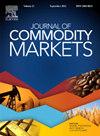Have the causal effects between equities, oil prices, and monetary policy changed over time?
IF 4.5
4区 经济学
Q1 BUSINESS, FINANCE
引用次数: 0
Abstract
We reexamine the contemporaneous causal effects between the U.S. stock prices, crude oil prices, and monetary policy from 2005 to 2022. Our study offers two main contributions. First, we generalize a novel identification approach based on exogenous intraday shifts in the volatility in futures markets from two markets to multiple markets. Second, we examine contemporaneous causal effects between the U.S. stock prices, crude oil prices, and monetary policy. We show that the coefficients measuring contemporaneous causality have substantially changed over time. Specifically, we find that since 2008 stock returns affect crude oil returns. This time variation is also evident in the effect of monetary policy on the crude oil returns. We show that this time variation is consistent with two explanations: the zero lower bound (ZLB) and increased synchronization of crude oil prices with the business cycle.
股票、油价和货币政策之间的因果效应是否随着时间的推移而改变?
我们重新研究了 2005 年至 2022 年美国股票价格、原油价格和货币政策之间的同期因果效应。我们的研究有两大贡献。首先,我们将基于期货市场波动性日内外生变化的新型识别方法从两个市场推广到多个市场。其次,我们研究了美国股票价格、原油价格和货币政策之间的同期因果效应。我们发现,衡量同期因果关系的系数随着时间的推移发生了很大变化。具体而言,我们发现自 2008 年以来,股票收益率会影响原油收益率。这种时间变化在货币政策对原油收益率的影响中也很明显。我们表明,这种时间变化符合两种解释:零下限(ZLB)和原油价格与商业周期的同步性增强。
本文章由计算机程序翻译,如有差异,请以英文原文为准。
求助全文
约1分钟内获得全文
求助全文
来源期刊

Journal of Commodity Markets
Multiple-
CiteScore
5.70
自引率
2.40%
发文量
53
期刊介绍:
The purpose of the journal is also to stimulate international dialog among academics, industry participants, traders, investors, and policymakers with mutual interests in commodity markets. The mandate for the journal is to present ongoing work within commodity economics and finance. Topics can be related to financialization of commodity markets; pricing, hedging, and risk analysis of commodity derivatives; risk premia in commodity markets; real option analysis for commodity project investment and production; portfolio allocation including commodities; forecasting in commodity markets; corporate finance for commodity-exposed corporations; econometric/statistical analysis of commodity markets; organization of commodity markets; regulation of commodity markets; local and global commodity trading; and commodity supply chains. Commodity markets in this context are energy markets (including renewables), metal markets, mineral markets, agricultural markets, livestock and fish markets, markets for weather derivatives, emission markets, shipping markets, water, and related markets. This interdisciplinary and trans-disciplinary journal will cover all commodity markets and is thus relevant for a broad audience. Commodity markets are not only of academic interest but also highly relevant for many practitioners, including asset managers, industrial managers, investment bankers, risk managers, and also policymakers in governments, central banks, and supranational institutions.
 求助内容:
求助内容: 应助结果提醒方式:
应助结果提醒方式:


